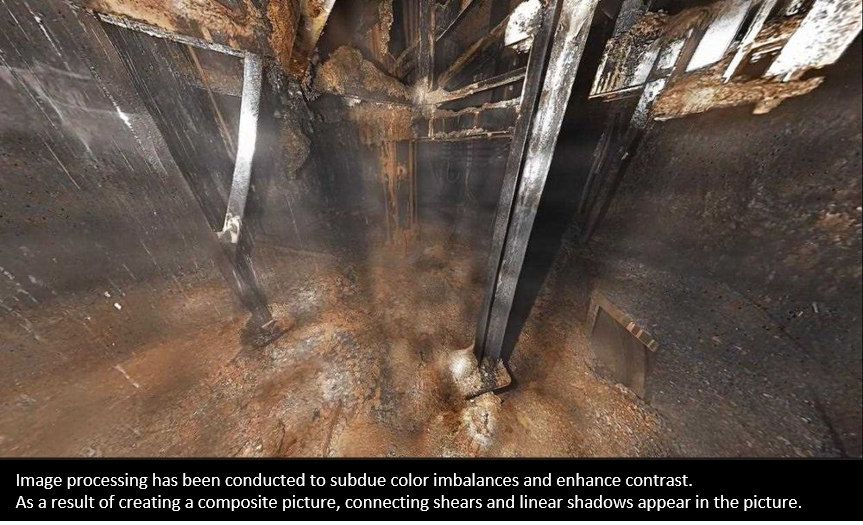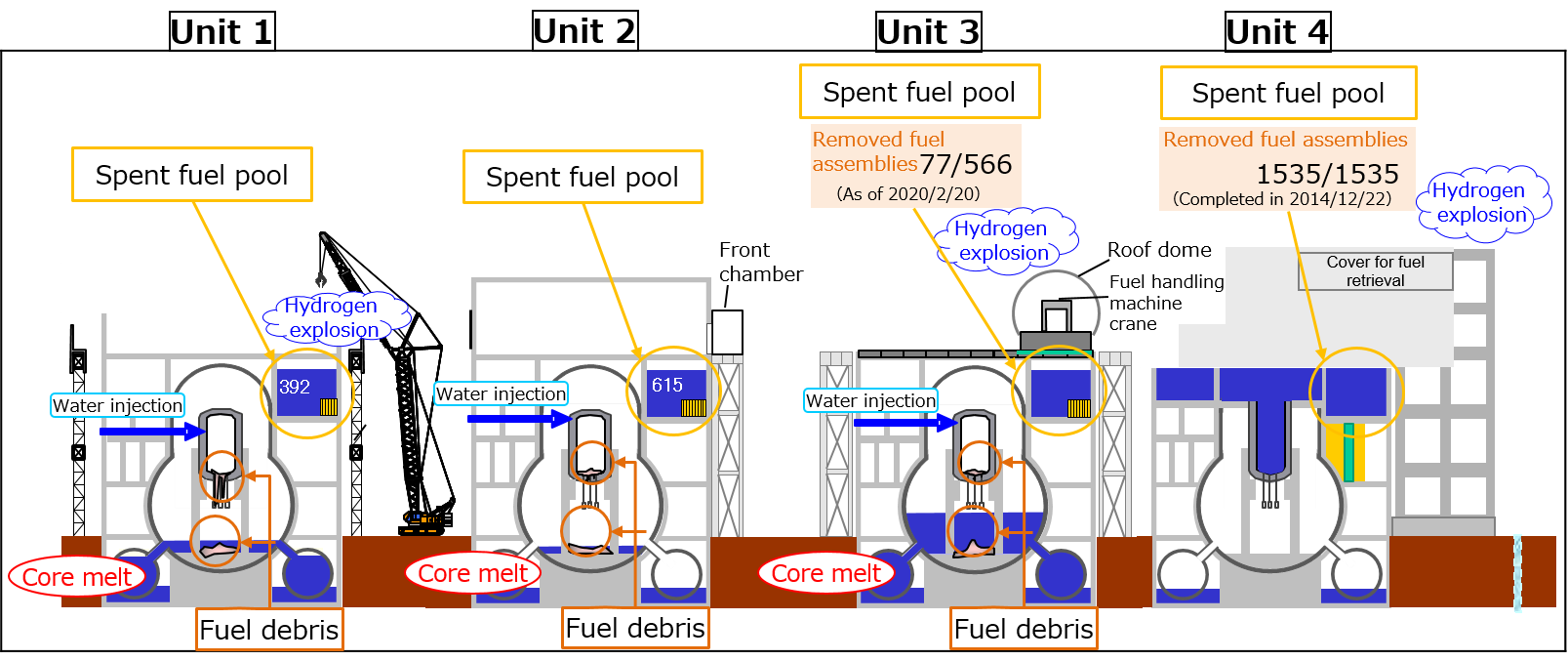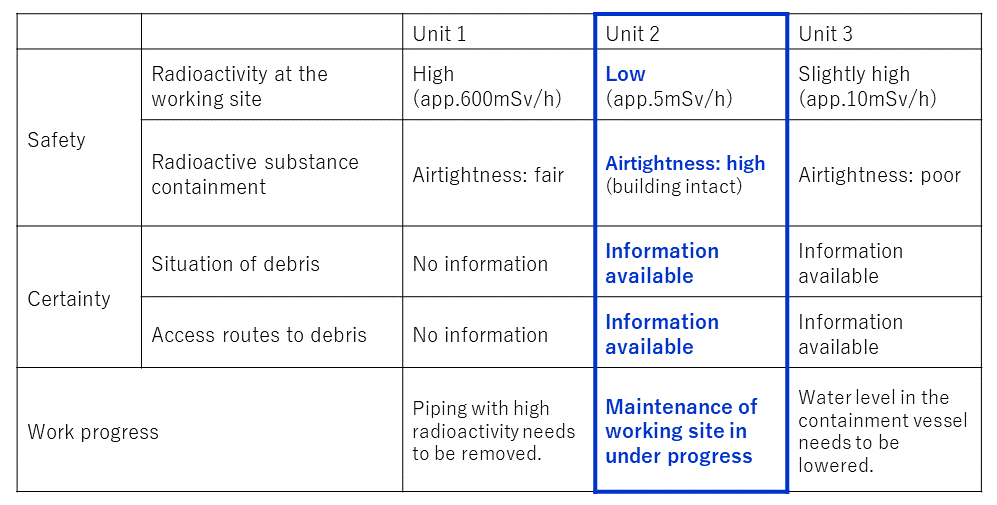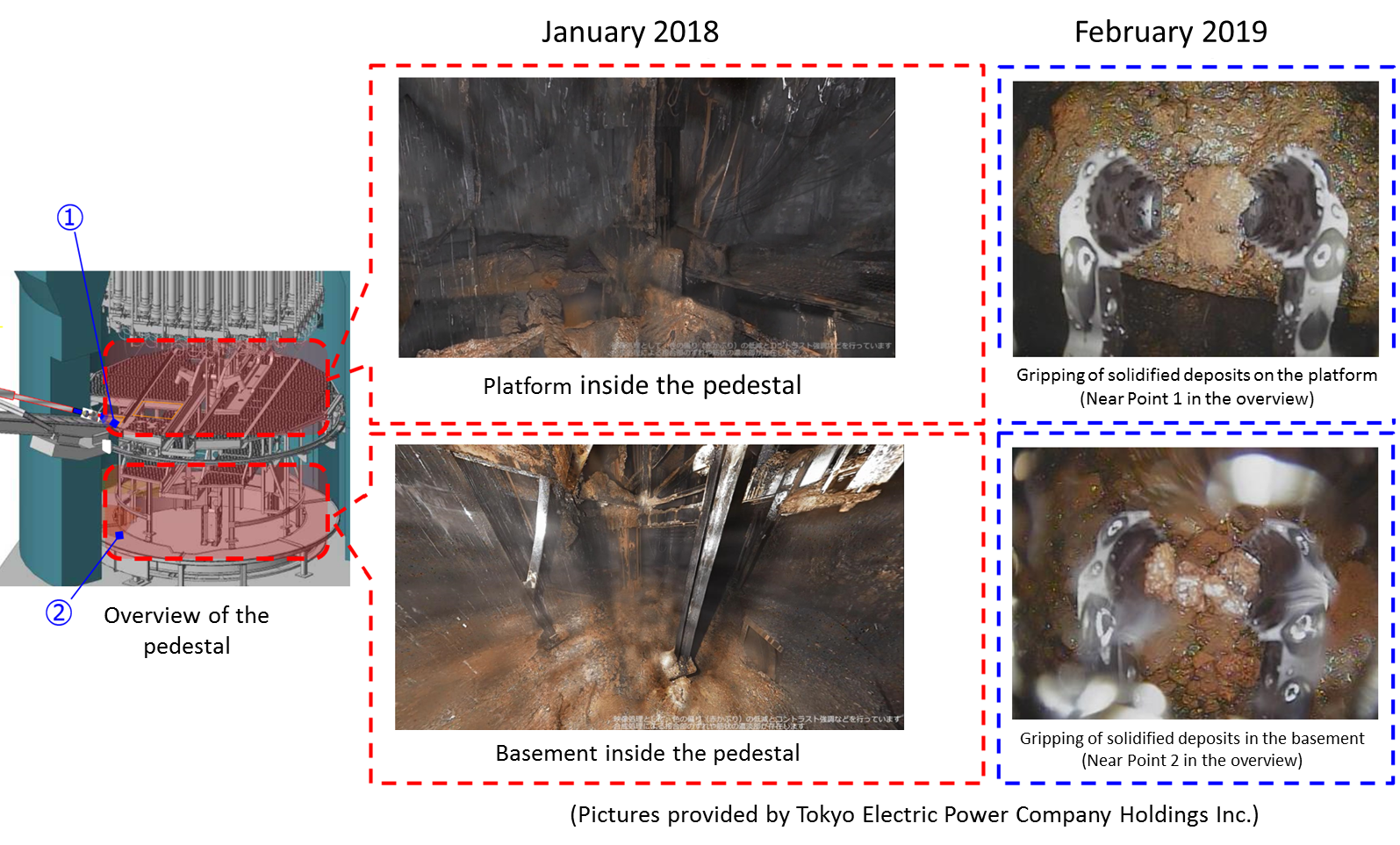Fukushima Daiichi Nuclear Power Station The challenge of retrieving “fuel debris” Article No.2: What obstacles will we face?
(in provisional translation)
(English ver.) 2020-05-21

Picture of the bottom of pedestal at Unit 2 reactor containment vessel (photograph taken at the time of the investigation in January 2018 and then image-processed) Picture provided by the International Research Institute for Nuclear Decommissioning (IRID) with image-processing conducted by Tokyo Electric Power Company Holdings, Inc.
Since the accident at TEPCO’s Fukushima Daiichi Nuclear Power Station (Fukushima Daiichi NPS) in March, 2011, efforts have been made toward decommissioning of the NPS. One of the challenges is the retrieval of the material known as “fuel debris” that remains inside the reactor containment vessel. Article No.1 of this series provided a basic understanding of “fuel debris” and the current situation of Unit 1 to 4 of the NPS. In this second Article, we will provide a detailed explanation of how fuel debris is to be retrieved.
Why has Unit 2 been selected as the first implementing unit for fuel debris retrieval?
Decommissioning of Fukushima Daiichi NPS and contaminated water management are progressing based on the “Mid-and-Long-Term Roadmap” established by the government, while emphasizing risk reduction and ensuring safety as the first priority, with a basic principle: “coexistence of reconstruction and decommissioning”.
The 5th revision of “Mid-and Long-Term Roadmap”, published in December, 2019, stipulates the following steps for fuel debris retrieval:
1) Determine the method of fuel debris retrieval from the first unit.
2) Start trial fuel debris retrieval from the first unit (Unit 2) by the end of 2021.
3) Gradually increase the scale of retrieval thereafter.
Nuclear fuel, along with other structural debris, melted down and solidified inside the reactor. This is referred to as “fuel debris” and it remains in Units 1, 2 and 3 of Fukushima Daiichi NPS.
Why has Unit 2 been selected as the first implementing unit for fuel debris retrieval?
The following table shows a comparison of Units 1, 2 and 3 in terms of safety, certainty, etc. Due to the fact that there was no hydrogen explosion at Unit 2, its building maintains higher airtightness compared with the Unit 1 and 3 buildings, which were partially damaged by hydrogen explosions. Therefore, Unit 2 has a higher capability of containing radioactive substances. It is important to prevent contaminated dust from spreading over the surrounding areas where efforts toward reconstruction are in progress with residents gradually returning home. Therefore, “capability of radioactive substance containment” is a key element for fuel debris retrieval.
Additionally, the first floor of the Unit 2 reactor building is in a better working condition with a lower level of radioactivity compared with the Unit 1 and 3 reactor buildings. Furthermore, investigation into the inside of the reactor containment vessel of Unit 2 is progressing, which has made more information available on the location of the fuel debris and access routes than for other units. Furthermore, in Unit 2, it is expected that the removal of the spent fuel, which is another important task to be accomplished, can be advanced simultaneously with the retrieval of the fuel debris.
Unit 2 was selected based on consideration of the various factors described above.
What is the inside of a reactor containment vessel like?
In Unit 2, it has been found that the reactor pressure vessel contains a substantial quantity of fuel debris, while a smaller quantity of fuel debris is contained inside the “pedestal”, a concrete structure supporting the pressure vessel.
The inside investigation of reactor containment vessel had been conducted in January 2018 and in February 2019. These investigations revealed the following:
- The platform, which is used as a working foothold inside the pedestal, will be accessible with appropriate devices.
- Those devices will also be able to reach the basement.
- Solidified deposits were found on the platform inside the pedestal and in the basement. Some of the deposits can be picked up and lifted by those devices.
A remote-operated robot arm is currently being developed as a means of accessing and retrieving fuel debris in the containment vessel where high levels of radioactivity persist. The inside of the containment vessel is small with a complex structure, with a number of devices installed, making it difficult to maneuver through. The picture of Unit 5, which has same shape as Unit 2 and currently not operational, provides some understanding of the complexity of the interior of these containment vessels. (Unit 5 was under periodical inspection when the earthquake occurred. As a result, it was saved from severe damage, and currently it is not operating.)
One of the existing openings leading to the inside of the containment vessel provides a potential entry point to the reactor containment vessel. This particular opening is called the “x-6 Penetration”. It is used for changing the devices that drive the reactor control rods. The x-6 Penetration has been selected among a number of existing openings because of its direct accessibility to the inside of the pedestal located below the reactor pressure vessel within the containment vessel, where the fuel debris is located. However, as you can see in the picture below, it is not a large opening.

There are waste cables and deposit inside the x-6 Penetration that need to be removed before access to the inside will be possible. Washing away fine deposit with pressurized water or cutting other obstacles such as cables into pieces could further spread dust containing radioactive substances within the containment vessel. In order to secure safer conditions, preparations are being made to enhance the capacity of the existing dust removal equipment with improved filters. Furthermore, improved methods of retrieving the fuel debris that can suppress the spread of the dust are being studied.
A device for fuel debris retrieval, after going through the x-6 Penetration, must reach the inside of the pedestal located below the reactor pressure vessel within the containment vessel, where fuel debris is located.
The picture below shows the inside of the pedestal located below the reactor pressure vessel. You can see that the space is extremely narrow and too short for an adult to stand. Additionally, the devices that are normally used to drive the reactor control rods, which are hanging from the roof, and other equipment, could hinder access to the fuel debris.

Another difficulty is that the access route to the inside of the pedestal is narrow and sloped as shown in the pictures below.

In addition to the difficulties described above, the situation inside the Unit 2 reactor containment vessel may have changed since the accident. Uncertainty exists with only the limited information on hand. Therefore, various contingencies must be considered and planned for in advance. Devices that can access and remove the fuel debris must be designed based on such considerations.
The access route for the robot arm mentioned above could also potentially be smaller than expected. To overcome this difficulty, the robot arm must be designed with sufficient strength to allow it lengthen to get inside of the pressure vessel and the pedestal without bending.
In view of the above, every piece of equipment for fuel debris retrieval must be developed for versatility, based on various assumptions without knowing the exact status of the inside of the containment vessel. In the next article, we will explain the current status of technological development including the conceptual design of the robot arm.
Division in charge
About the article
Nuclear Accident Response Office, Electricity and Gas Industry Department
About Special Contents
Research and Public Relations Office, Policy Planning and Coordination Division, Commissioner’s Secretariat
![]() The original Japanese text of this article; Click here
The original Japanese text of this article; Click here



